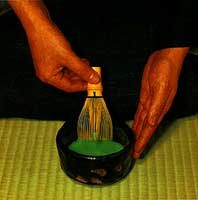On Wabi-Sabi Weekends, I post excerpts from my book, Simply Imperfect: Revisiting the Wabi-Sabi House.
“The art of chanoyu consists in nothing else but in boiling water, making tea, and sipping it.” — Tea Master Sen no Rikyu
Though most Westerners don’t see the delight in spending four hours kneeling (painfully) to watch someone build a charcoal fire and whisk a bitter green powder known as matcha into a froth, Chanoyu, or Tea (literally “hot water for tea”), has been a revered art in Japan for centuries. We could learn a lot from the ceremony’s thoughtfully drawn-out rituals. Tea practitioners are accomplished in the arts of flowers, fine cuisine and—most importantly—etiquette and hospitality. During Tea ceremony, a poem is read, a scroll is unveiled and the bamboo tea scoop is given a poetic name. The season is deeply honored in everything from the food to the pottery, and Sen no Rikyu’s canons are revisited. For that alone, everyone should attend at least one Tea ceremony.
Rikyu’s four principles of Tea—harmony (wa), respect (kei), purity (sei), and tranquility (jaku)—are the means to any good life. “Give those with whom you find yourself every consideration” has been a primary Tea tenet since Rikyu’s wabi Tea style took hold, in a medieval society rife with warfare. In Rikyu’s Tea house—and in Tea houses across Japan—samurai set aside their rank and swords and bowed humbly upon entering the Tea room. Inside, they were equals. Nanbo-roku, one of the oldest and most important Tea textbooks, said: “In this thatched hut there ought not to be a speck of dust of any kind; both master and visitors are expected to be on terms of absolute sincerity; no ordinary measures of proportion or etiquette or conventionalism are to be followed. A fire is made, water is boiled, and tea is served; this is all that is needed here, no other worldly considerations are to intrude.”
“Tea brings people together in a non-threatening place to escape the modern world; then they can go back out and take that with them,” Gary Cadwallader, an American-born Tea master who teaches Rikyu’s wabi style of Tea at the Urasenke Center in Kyoto, explained to me. Tea masters teach that every meeting is a once-in-a-lifetime occasion to enjoy good company, beautiful art and a cup of tea. (This is known as ichigo, ichie, “once in a lifetime.”) “If a friend visits you, make him tea, wish him welcome warmly with hospitality,” Rikyu’s predecessor, Jo-o, wrote. “Set some flowers and make him feel comfortable.”
This hospitality endures in Japan today, in the common phrase shaza kissa, “Well, sit down and have some tea.” It’s a phrase that can change everything. A cup of tea makes everyone a friend.
The Ten Virtues of Tea
When Zen priest Eisai brought tea seeds from China to Japan in the 12th century, he also imparted its ten virtues.
1. It has the blessing of all deities.
2. It promotes filial piety.
3. It drives away evil spirits.
4. It banishes drowsiness.
5. It keeps the five internal organs in harmony.
6. It wards off disease.
7. It strengthens friendship.
8. It disciplines body and mind.
9. It destroys all passions.
10. It gives a peaceful death.
Sen no Rikyu’s Seven Rules of Tea
- Arrange the flowers as they are in the fields.
- Lay the charcoal so it boils the water.
- Create a cool feeling in summer.
- Make sure the guests are warm in winter.
- Be sure everything is ready ahead of time and do not fall behind.
- Be prepared for rain even if it is not raining.
- Always be mindful of the guests. (They’re your first, your last, your everything.)
